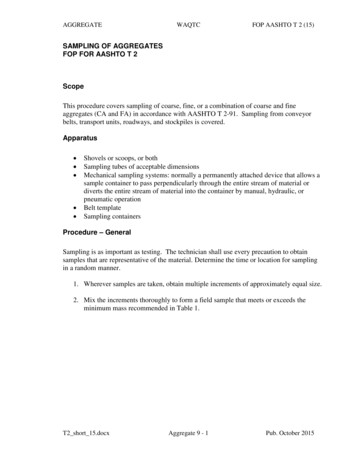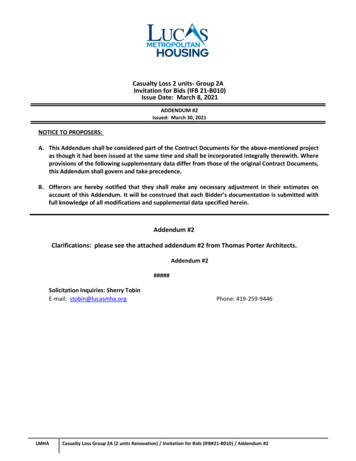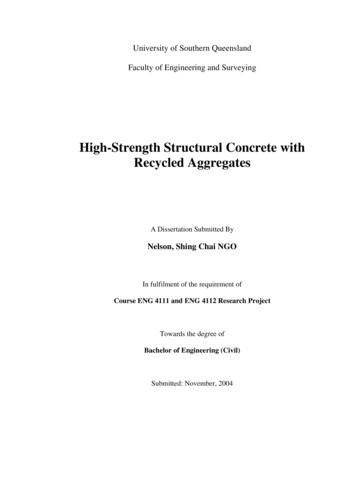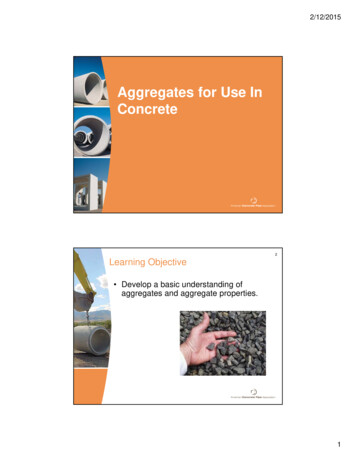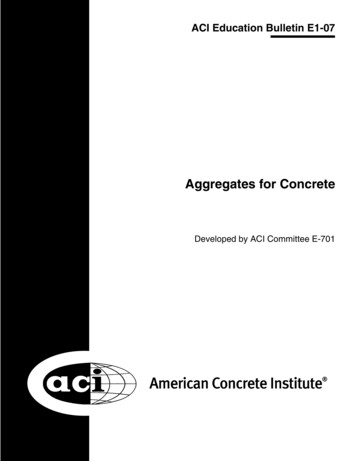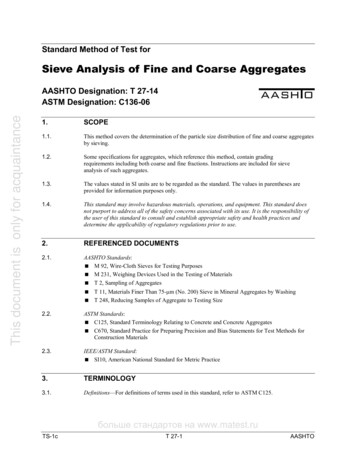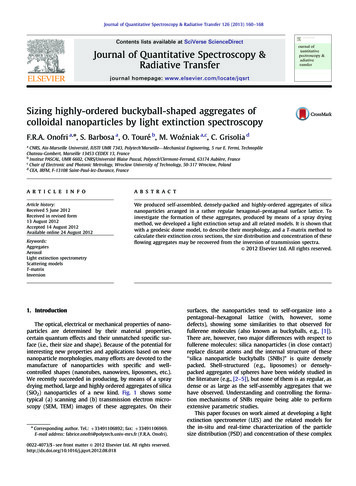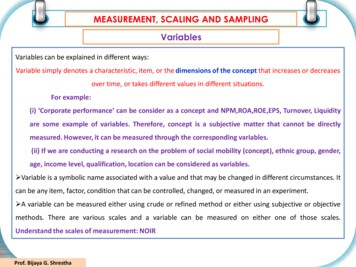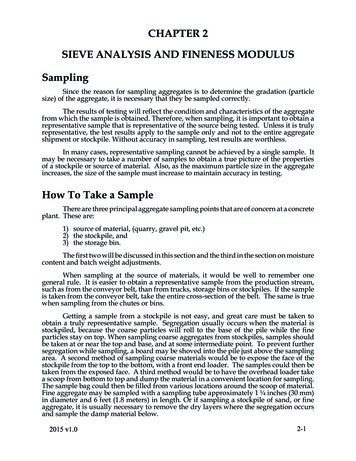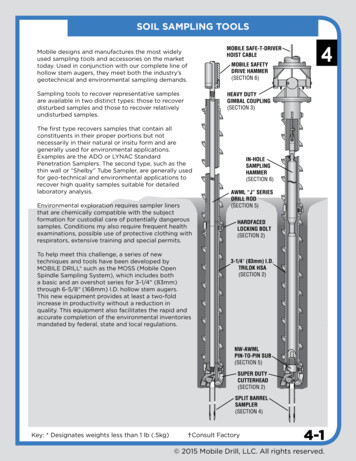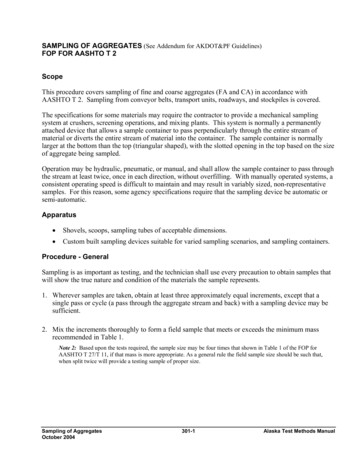
Transcription
SAMPLING OF AGGREGATES (See Addendum for AKDOT&PF Guidelines)FOP FOR AASHTO T 2ScopeThis procedure covers sampling of fine and coarse aggregates (FA and CA) in accordance withAASHTO T 2. Sampling from conveyor belts, transport units, roadways, and stockpiles is covered.The specifications for some materials may require the contractor to provide a mechanical samplingsystem at crushers, screening operations, and mixing plants. This system is normally a permanentlyattached device that allows a sample container to pass perpendicularly through the entire stream ofmaterial or diverts the entire stream of material into the container. The sample container is normallylarger at the bottom than the top (triangular shaped), with the slotted opening in the top based on the sizeof aggregate being sampled.Operation may be hydraulic, pneumatic, or manual, and shall allow the sample container to pass throughthe stream at least twice, once in each direction, without overfilling. With manually operated systems, aconsistent operating speed is difficult to maintain and may result in variably sized, non-representativesamples. For this reason, some agency specifications require that the sampling device be automatic orsemi-automatic.Apparatus Shovels, scoops, sampling tubes of acceptable dimensions. Custom built sampling devices suitable for varied sampling scenarios, and sampling containers.Procedure - GeneralSampling is as important as testing, and the technician shall use every precaution to obtain samples thatwill show the true nature and condition of the materials the sample represents.1. Wherever samples are taken, obtain at least three approximately equal increments, except that asingle pass or cycle (a pass through the aggregate stream and back) with a sampling device may besufficient.2. Mix the increments thoroughly to form a field sample that meets or exceeds the minimum massrecommended in Table 1.Note 2: Based upon the tests required, the sample size may be four times that shown in Table 1 of the FOP forAASHTO T 27/T 11, if that mass is more appropriate. As a general rule the field sample size should be such that,when split twice will provide a testing sample of proper size.Sampling of AggregatesOctober 2004301-1Alaska Test Methods Manual
TABLE 1Sample SizesMinimum Masskg (lb)Nominal MaximumSize* mm (in.)2.364.759.512.519.025.037.550637590(No. 8)(No. 4)(3/8)(1/2)(3/4)(1)(1 1/2)(2)(2 1/2)(3)(3 (110)(165)(220)(275)(330)(385)* One sieve larger than the first sieve to retain more than 10 percent of the material using an agency specified set ofsieves based on cumulative percent retained. Where large gaps in specification sieves exist, intermediate sieve(s) maybe inserted to determine nominal maximum size.Procedure – Specific SituationsIn all situations, determine the time or location for sampling in a random manner.A. Conveyor BeltsMethod A (From the Belt): Stop the belt. Set the sampling device in place on the belt, avoidingintrusion by adjacent material. Scoop off the sample, including all fines.Method B (From the Belt Discharge): Pass a sampling device through the full stream of the materialas it runs off the end of the conveyor belt. The sampling device may be manually, semi-automatic orautomatically powered. The sample container shall pass through the stream at least twice, once ineach direction, without overfilling while maintaining a constant speed during the sampling process.B. Transport UnitsDivide the unit into four quadrants. Dig down approximately 0.3 m (1 ft) in each quadrant andobtain material. Combine to form a single sample.C. RoadwaysObtain three increments of approximately equal size and combine. Take the full depth of thematerial to be sampled, being careful to exclude underlying material.Note 3: If from a berm or windrow the entire cross-section must be sampled after the last mixing pass and prior tospreading and compacting. This may yield extra large samples and may not be the preferred sampling location. Donot sample from the beginning or the end of a berm or windrow.Alaska Test Methods Manual301-2Sampling of AggregatesOctober 2004
D. StockpilesNote 4: Sampling at stockpiles should be avoided whenever possible due to problems involved in obtaining arepresentative gradation of material1. Create, with a loader if one is available, vertical faces in the top, middle, and bottom third of thestockpile. When no equipment is available a shovel may be used to create vertical faces.2. Prevent sloughing by shoving a flat board in against the vertical face. Sample from thehorizontal surface at the intersection of the horizontal and vertical faces. Take at least oneincrement from each of the top, middle, and bottom thirds of the pile – and combine.3. When sampling sand, remove the outer layer that may have become segregated. Using asampling tube, obtain material from five random locations on the pile and mix thoroughly toform one sample.Sampling of AggregatesOctober 2004301-3Alaska Test Methods Manual
Addendum WAQTC FOP for AASHTO T 2Following are guidelines for the use of WAQTC FOP for AASHTO T 2 by the State of Alaska DOT&PF.1. When sampling sand from a stockpile, the use of the sampling tube is optional. When sampling withoutthe use of a sampling tube, the sample should be obtained in three increments minimum.2. Table 1, Minimum (Field) Sample Size, is modified to allow for reduced sample sizes in accordance withthe Alaska DOT&PF Guidelines for WAQTC FOP for AASHTO T 27/T 11 (i.e. the field sample size issuch that when split twice, it will provide a testing sample of proper size for WAQTC FOP for AASHTOT 27/T 11).TABLE 1Sample SizesNominal MaximumMinimum Mass,Size*,kglbStandard Alternatemminches2.36No. 810254.75No. Nominal Maximum Size: One sieve larger than the firstsieve to retain more than 10 percent of the material using anagency specified set of sieves based on cumulative percentretained. Where large gaps in specification sieves exist,intermediate sieve(s) may be inserted to determine nominalmaximum size.Alaska Test Methods Manual301-4Sampling of AggregatesOctober 2004
REDUCING SAMPLES OF AGGREGATES TO TESTING SIZEFOP FOR AASHTO T 248ScopeThis procedure covers the reduction of samples to the appropriate size for testing in accordance withAASHTO T 248. Techniques are used that minimize variations in characteristics between test samplesand field samples.This procedure applies to fine aggregate (FA), coarse aggregate (CA), and mixes of the two, and mayalso be used on soils.Samples of fine aggregates that are drier than the saturated surface dry (SSD) condition shall be reducedby a mechanical splitter according to Method A. Samples of FA that are wetter than SSD shall bereduced by Method B, or the entire sample may be dried to the SSD condition, using temperatures thatdo not exceed those specified for any of the tests contemplated, and then reduced to test sample sizeusing Method A. Samples of CA or mixtures of FA and CA may be reduced by either method. As aquick determination, if the fine aggregate will retain its shape when molded with the hand it is wetterthat SSD.ApparatusMethod A – Mechanical SplitterSample splitter shall have an even number of equal width chutes, but not fewer than 8 for coarseaggregate or 12 for FA, which discharge alternately to each side of the splitter. The minimum width ofindividual chutes shall be approximately 50 percent larger than the largest particles in the sample to besplit. For dry fine aggregate where the total sample passes the 9.5 mm (3/8 in.) sieve, the maximumchute width shall be 19 mm (3/4 in.). The splitter shall be equipped with two receptacles to hold the twohalves of the sample following splitting. It shall also be equipped with a hopper or straightedge pan thathas a width equal to or slightly less than the overall width of the assembly of chutes, by which thesample may be fed at a controlled rate to the chutes. The splitter and accessory equipment shall be sodesigned that the sample will flow smoothly without restriction or loss of material.Method B – Quartering Straightedge scoop, shovel, or trowelBroom or brushCanvas or plastic sheet, approximately 2 m by 3m (6 by 9 ft)Sample PreparationIf the FA sample is wetter than the SSD condition and Method A – Mechanical Splitter is to be used, drythe material using temperatures not exceeding those specified for any of the tests contemplated for thesample.Note 1: It may be undesirable to split some FA / CA mixtures that are over SSD condition using Method A.Reducing Samples of AggregateTo Testing SizeOctober 2004303-1Alaska Test Methods Manual
ProcedureMethod A – Mechanical SplitterPlace the sample in the hopper or pan and uniformly distribute it from edge to edge so thatapproximately equal amounts flow through each chute. The rate at which the sample is introduced shallbe such as to allow free flowing through the chutes into the hoppers below. Split the sample from one ofthe two hoppers as many times as necessary to reduce the sample to the size specified for the intendedtest. The portion of the material collected in the other receptacle may be reserved for reduction in sizefor other tests. As a check for effective splitting determine the mass of each part of the split. If the ratioof the two masses differs by more than 5 percent, corrective action must be taken.CalculationSplitter check: 5127 total sample massSplitter pan #1: 2583Splitter pan #2: 25442544X100 98.52583100-98.5 1.5%Method B – QuarteringUse either of the following two procedures or a combination of both.Quartering on a clean, hard, level surface:1. Place the sample on a hard, clean, level surface where there will be neither loss of material nor theaccidental addition of foreign material.2. Mix the material thoroughly by turning the entire sample over a minimum of three times. With thelast turning, shovel the entire sample into a conical pile by depositing each shovelful on top of thepreceding one.3. Flatten the conical pile to a uniform thickness and diameter by pressing down with a shovel. Thediameter should be four to eight times the thickness.4. Divide the flattened pile into four approximately equal quarters with a shovel or trowel.5. Remove two diagonally opposite quarters, including all fine material, and brush the cleared spacesclean.6. Successively mix and quarter the remaining material until the sample is reduced to the desired size.7. The final test sample consists of two diagonally opposite quarters.Alaska Test Methods Manual303-2Reducing Samples of AggregateTo Testing SizeOctober 2004
Quartering on a canvas or plastic sheet:1. Place the sample on the sheet.2. Mix the material thoroughly by turning the entire sample over a minimum of three times. With thelast turning, shovel the entire sample into a conical pile by depositing each shovelful on top of thepreceding one. Alternately lift each corner of the sheet and pulling it over the sample toward thediagonally opposite corner, causing the material to be rolled.3. Flatten the conical pile to a uniform thickness and diameter by pressing down with a shovel. Thediameter should be four to eight times the thickness.4. Divide the flattened pile into four approximately equal quarters with a shovel or trowel, or, insert astick or pipe beneath the sheet and under the center of the pile, then lift both ends of the stick,dividing the sample into two roughly equal parts. Remove the stick leaving a fold of the sheetbetween the divided portions. Insert the stick under the center of the pile at right angles to the firstdivision and again lift both ends of the stick, dividing the sample into four roughly equal quarters.5. Remove two diagonally opposite quarters, being careful to clean the fines from the sheet.6. Successively mix and quarter the remaining material until the sample size is reduced to the desiredsize.7. The final test sample consists of two diagonally opposite quarters.Reducing Samples of AggregateTo Testing SizeOctober 2004303-3Alaska Test Methods Manual
Alaska Test Methods Manual303-4Reducing Samples of AggregateTo Testing SizeOctober 2004
SIEVE ANALYSIS OF FINE AND COARSE AGGREGATESFOP FOR AASHTO T 27 (See Addendum for AKDOT&PF Guidelines)MATERIALS FINER THAN 75 µm (No. 200) SIEVE IN MINERAL AGGREGATE BYWASHING (See Addendum for AKDOT&PF Guidelines)FOP FOR AASHTO T 11ScopeSieve analyses determine the gradation or distribution of aggregate particles within a given sample inorder to determine compliance with design and production standards.Accurate determination of material smaller than 75 µm (No. 200) cannot be made with AASHTO T 27alone. If quantifying this material is required, it is recommended that AASHTO T 27 be used inconjunction with AASHTO T 11. Following the procedure in AASHTO T 11, the sample is washedthrough a 75 µm (No. 200) sieve. The amount of material passing this sieve is determined by comparingdry sample masses before and after the washing process.This procedure covers sieve analysis in accordance with AASHTO T 27 and materials finer than 75 µm(No. 200) in accordance with AASHTO T 11 performed in conjunction with AASHTO T 27. Theprocedure includes three method choices, A, B and C.Apparatus Balance or scale: Capacity sufficient for the masses shown in Table 1, accurate to 0.1 percent ofthe sample mass or readable to 0.1 g. Meeting the requirements of AASHTO M 231. Sieves – Meeting the requirements of AASHTO M 92. Mechanical sieve shaker – Meeting the requirements of AASHTO T 27. Suitable drying equipment (see FOP for AASHTO T 255). Containers and utensils: A pan or vessel of a size sufficient to contain the sample covered withwater and to permit vigorous agitation without loss of any part of the sample or water.Sample PreparationObtain samples in accordance with the FOP for AASHTO T 2 and reduce to the size shown in Table 1 ina
AASHTO T 2. Sampling from conveyor belts, transport units, roadways, and stockpiles is covered. The specifications for some materials may require the contractor to provide a mechanical sampling system at crushers, screening operations, and mixing plants. This system is normally a permanently attached device that allows a sample container to pass perpendicularly through the entire stream of .
